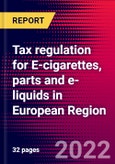This tax regulatory report provides detailed analysis and comparison of existing tax systems in each country of the European Region relatively to E-cigarettes, their parts and bottled E-liquid. Report includes a complete list of definitions of E-cigarettes, taxation rules in each country and additional visual data charts for understanding insights about tax burden in E-cigarette and E-liquid markets in the selected region. This Report will be useful for existing and new brands, manufacturers, distributors and market analysts engaged in E-cigarette business in the European Region. In the report, sales, excise and special taxes and calculated tax burden for different categories of vaping products are reviewed.
This report covers the tax regulations for final vaping products in Europe. In total, the regulations of 45 countries have been analyzed. Vaping products in Europe are subjected to VAT and excise taxes. Standard VAT rates are applied in all European countries, while excise taxes are applicable in 25 countries, whereof 2 countries have validated taxation for vaping products starting from January 1, 2022.
EU-wide tax on vapor products and excise taxes in some individual countries are still under consideration. The highest tax burden is set for bottled e-liquid, while the lowest one is applied for empty e-cigs. The countries with the highest tax burden on e-liquid containing e-cigs and parts are Montenegro, Portugal and Finland. The lowest taxes in the EU are in Luxembourg and Malta.
The main product categories, which have been analyzed in this report in the scope of tax burden and end-user price, are:
- prefilled pods and cartridges, prefilled disposables (closed systems);
- bottled E-liquid;
- empty devices, batteries and parts (open systems).
The peculiarities for the vaping products excise taxes are as follows:
- The most common tax base is the volume of liquid (either applied to e-liquid in general, or only to nicotine-containing
- e-liquid);
- The excise tax on empty e-cigarettes is valid only in Iceland (calculated from gross sales) and Russia (calculated
- per unit);
- In Denmark and Sweden, the tax rate per milliliter of e-liquid varies according to the level of nicotine concentration;
- Nicotine by weight is used as a tax base in Germany and Latvia;
- In Latvia complex tax is applied, which combines two bases: the volume of liquid and the weight of nicotine
Table of Contents
- Executive Summary
- European Vaping Taxation Horizons
- European Vaping Products Tax Regime
- European VAT Tax Rates
- Excise Taxes for Vaping Products in the EU
- Excise Taxes for Vaping Products for Non-EU Members
- References
- Appendix A. Definitions of the European Regulatory Provisions for Vaping Products
List of Charts
Chart 1. End-user prices and taxes for empty E-cigarettes and parts in Europe
Chart 2. End-user prices and taxes for prefilled E-cigarettes and parts in Europe
Chart 3. End-user prices and taxes for bottled E-liquid in Europe
List of Tables
Table 1. European VAT Tax Rates for Vaping Products
Table 2. Excise Taxes for Vaping Products in the European Union
Table 3. European (Non-EU) Excise Taxes for Vaping Products
Table 4. Definitions of the European Regulatory Provisions for Vaping Products








